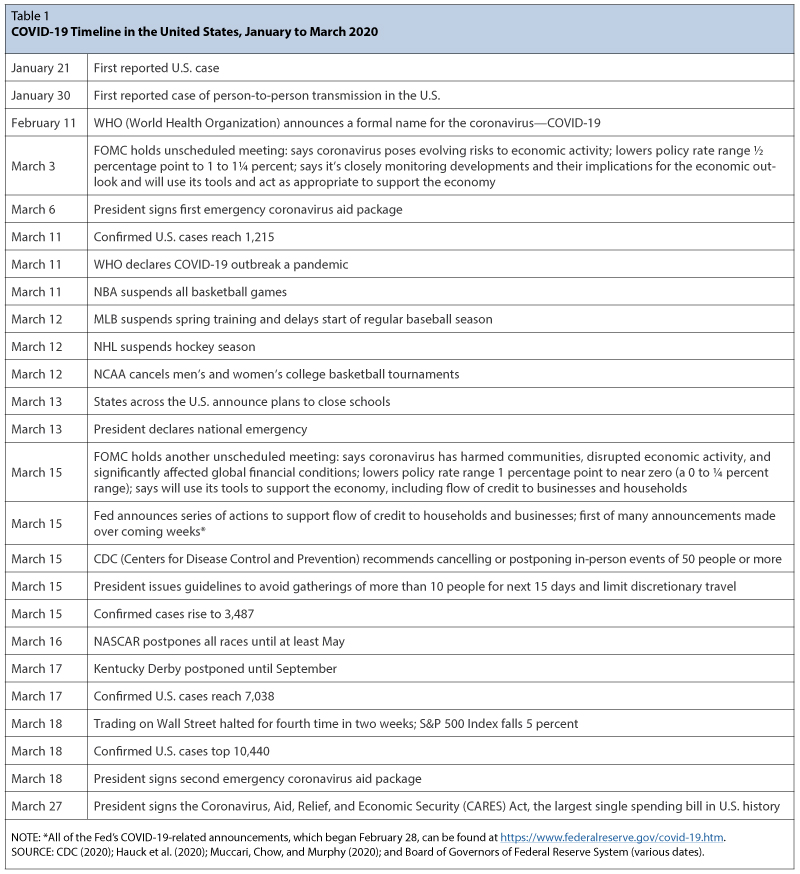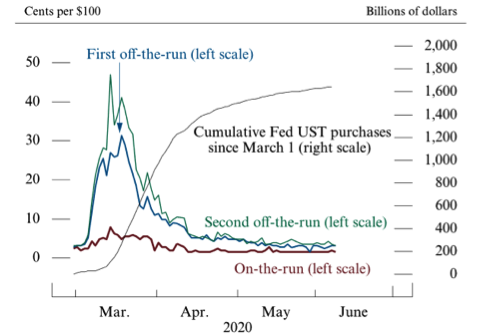COVID-19’s Effects on the Economy and the Fed’s Response

"The Federal Reserve's response to this extraordinary period has been guided by our mandate to promote maximum employment and stable prices for the American people, along with our responsibilities to promote stability of the financial system."1
—Jerome H. Powell, Chair of the Board of Governors of the Federal Reserve System
What Does the Fed Do?
As the central bank of the United States, the Federal Reserve's (Fed's) mission is to promote the effective operation of the U.S. economy. It uses monetary policy—actions to achieve maximum employment and stable prices (also known as its "dual mandate")—to support economic growth. Effective monetary policy complements fiscal policy—the use of government spending and tax policies to affect economic conditions. The Fed also promotes the stability of the financial system; stable financial markets are necessary for a well-functioning economy.2
The Fed plays a particularly important role in quelling financial and economic crises. In fact, it was created in part to do just that: After decades of destabilizing banking panics and other crises, the Fed was founded in 1913 to provide the nation with a safe, flexible, and stable monetary and financial system. When crises arise, the Fed is authorized to act as the "lender of last resort." That is, in certain circumstances the Fed may provide funds to the financial system when they are urgently needed and market sources have been exhausted. Doing so keeps the financial system functioning and prevents economic downturns from deepening. This authority came into play with the onset of the COVID-19 pandemic. Here we look at the substantial economic shock brought on by the pandemic and the steps the Fed took in the initial weeks to aid the economy.
What Shape Was the U.S. Economy in Prior to the Pandemic?
In early 2020, before the pandemic took hold, the U.S. economy was in very good shape. February marked the 128th month (and the ultimate peak) of the longest economic expansion in U.S. history. Employment was growing solidly, with February's unemployment rate of 3.5 percent the lowest in 50 years. Employees' wages were rising on the whole, although gradually. Lower-income workers were also benefitting from employment gains. Moreover, while inflation was a bit low from the Fed's perspective, it was stable. Taken together, these indicators painted a rosy picture of a strong and stable economy.
When the Pandemic Set In, What Happened to the U.S. Economy?
The COVID-19 pandemic and the steps taken to protect public health hit the U.S. economy in early 2020 with considerable speed and scope. The United States announced its first reported case of the virus on January 21 and the first death from it on February 29. To limit the spread of the virus, health experts recommended widespread social distancing (keeping a distance of at least six feet between people). This policy resulted in the closing of all "non-essential" businesses and activities and the use of shelter-at-home strategies for all non-essential employees, steps that many businesses and households implemented swiftly (Table 1). As a result, by mid-March, entire parts of the economy had been shut down, which had two major effects.

First, economic activity was substantially disrupted, ending the U.S. economic expansion. Spending on goods and services plunged (Figure 1). With many businesses closed, millions of workers were laid off. The unemployment rate surged to an 80-year high—to 14.7 percent in April and 13.3 percent in May (Figure 2). More jobs were lost in the two months ending in April 2020 than had been created over the preceding expansion, which had lasted nine years (Figure 3). And the rise in joblessness was especially severe for lower-wage workers, women, African Americans, and Hispanics. Real gross domestic product (GDP), which measures the value of the nation's total economic output, fell at a 5 percent annual rate in the first quarter of 2020 followed by an eye-popping 33 percent fall in the second quarter. Although these data provide a sense of the overall effects of the pandemic on the economy, they do not capture the severe hardships that set in for many, including the financial stresses that can accompany sudden job loss.
Figure 1
Spending Plunged
Consumer spending decreased 6.6 percent ($1 trillion) in March 2020 and 12.6 percent ($1.8 trillion) in April.
NOTE: The data start in November 2007 to include the Great Recession.
SOURCE: FRED®, Federal Reserve Bank of St. Louis; https://fred.stlouisfed.org/gr... and https://fred.stlouisfed.org/graph/?g=r60v, accessed July 8, 2020.
Figure 2
Unemployment Surged
The unemployment rate bounced from a low of 3.5 percent in February 2020 to a peak of 14.7 percent in April and 13.3 in May.
NOTE: The data start in November 2007 to include the Great Recession.
SOURCE: FRED®, Federal Reserve Bank of St. Louis; https://fred.stlouisfed.org/graph/?g=r5AM, accessed July 8, 2020.
Figure 3
Employment Plummeted
Total nonfarm payroll is a measure of employment. The measure peaked at 152,463,000 people employed in February 2020. By April, employment had dropped to 130,303,000.
NOTE: The data start in November 2007 to include the Great Recession.
SOURCE: FRED®, Federal Reserve Bank of St. Louis; https://fred.stlouisfed.org/graph/?g=r5AO, accessed July 8, 2020.

Figure 4
Stresses Emerged Even in Some Treasury Markets
NOTE: UST, U.S. Treasury securities. A bid-ask spread is the difference in the price offered to sell versus buy a security; a widening spread indicates increased difficulty in finding a seller-buyer pair to agree on a trade. The red line shows that the most recently issued Treasury securities (referred to as "on the run") traded smoothly during the initial weeks of the pandemic. In contrast, the green and blue lines show that investors had trouble finding buyers of older Treasury securities (relative to the on-the-run security, the first off-the-run security is the next youngest); the increase in these lines signaled a deterioration in market functioning. Then the green and blue lines declined—conditions in Treasury markets improved—as the Fed's securities purchases, the black line, ramped up.
SOURCE: Board of Governors of the Federal Reserve System (2020).
Second, and even more immediately, the economic shutdown severely affected U.S. financial markets. Well before the data discussed above became available, it was increasingly clear that the pandemic would have serious adverse effects on the economy. And any disruptions to economic activity would also interrupt incoming earnings and other cash flows for many households, businesses, and state and local governments. In response to this growing realization, many businesses and investors sought to increase their holdings of cash and other very "liquid" assets, and some did so by selling their holdings of other assets. By early March, this rush to raise cash caused severe strains across many financial markets. In U.S. Treasury securities markets, for example, the difference between the prices offered to sell and buy some securities widened considerably, making it difficult for trades to occur (Figure 4). Stress in the Treasury market, normally among the most liquid markets in the world, signaled financial stresses more broadly.3 Indeed, many businesses and state and local governments that regularly cover their near-term expenses by selling short-term securities to raise cash started to have difficulty raising enough money to operate, including for expenses such as payroll, leases, and payments to suppliers. The resultant "liquidity squeeze"—where access to cash dries up even for those that had been operating smoothly just days before—was particularly severe in mid-March and threatened to greatly amplify the pandemic's negative effects on the economy.
How Did the Fed Respond?
In keeping with its mission, the Fed acted swiftly to address the economic and financial effects of the pandemic. It rapidly lowered the target range for its policy rate, the federal funds rate, to near zero to bolster the economy; took steps to stabilize the financial system; and undertook programs to support the flow of credit in the economy.4
Figure 5
The Fed Reduced Its Policy Rate to Near Zero
The federal funds rate is the Fed's policy rate; the effective federal funds rate is the volume-weighted median of the rates at which these funds transact in markets. The Fed uses its monetary policy tools to ensure the effective rate typically stays within the FOMC's target policy range.
NOTE: The data start in November 2007 to include the Great Recession.
SOURCE: FRED®, Federal Reserve Bank of St. Louis; https://fred.stlouisfed.org/graph/?g=rbkO, accessed July 8, 2020.
Specifically, during two unscheduled meetings on March 3 and March 15, the Fed's monetary policymaking body, the Federal Open Market Committee (FOMC), voted to reduce the target range for the federal funds rate by a total of 1½ percentage points, dropping it to near zero (Figure 5). Moreover, the FOMC made it clear that it intended to keep that setting for a good while—until it could be confident that the economy had weathered recent events and was back on track for the Fed to achieve its dual mandate. Taken together, these interest rate actions helped keep borrowing costs low for households and businesses at a critical time. These actions will also help spur spending and investment when the economy emerges from the depths of the shock.
Figure 6
The Fed's Holdings of Securities Jumped Up
SOURCE: FRED®, Federal Reserve Bank of St. Louis; https://fred.stlouisfed.org/graph/?g=r5Bn, accessed July 8, 2020.
The Fed also took a number of steps to "unfreeze" key financial markets. Such steps not only help these markets run smoothly, they also encourage economic activity by enabling the Fed's low policy rate to pass to other interest rates and to affect financial conditions more broadly in the economy. First, the Fed announced an enormous expansion of its purchases of securities, one that increased its holdings by more than $2 trillion in the first two months of this policy (Figure 6). Such purchases keep markets working when assets are otherwise difficult to sell, inject cash into the economy, and also convey that the Fed stands ready to "backstop" (reinforce) important parts of the financial system. These purchases helped restore more normal functioning of crucial markets, including the market for Treasury securities, which, as Figure 4 highlights, was under significant stress.5 Second, the Fed lowered the cost banks face when borrowing directly from the Fed's discount window and encouraged them to lean on this option, if needed, to help meet their customers' demands for credit. The Fed also enlarged its offerings of "swap lines" with foreign central banks to improve access to dollar liquidity around the globe.6 In addition, the Fed boosted its offerings of repurchase agreements (repos) with eligible financial counterparties; in this transaction, the Fed temporarily lends cash, taking as collateral a Treasury or other safe security. The use of the Fed's discount window, swap lines, and repo operations climbed in the early weeks of the shock and then retraced as financial markets stabilized.
To help provide credit to businesses, households, and communities where it was not otherwise available, the Fed also introduced several liquidity and lending facilities. The Fed is authorized to take these steps only in special circumstances and with specific approval.7 Overall, the Fed introduced 11 facilities to support various types of funding and credit markets—including markets for financial instruments such as commercial paper, corporate bonds, municipal bonds, and asset-backed securities—and businesses of all sizes.8 With these facilities, the Fed aimed to keep key financial markets and the flow of credit running in the economy. Some of these facilities began operating quite quickly, while others took more time to establish. By mid-June, a point before all of the facilities had become operational, these programs in total provided about $150 billion in funds. In many cases, however, just knowing the Fed was providing a backstop source of liquidity or credit helped restore confidence and activity in these markets.
Conclusion
Though the COVID-19 pandemic is primarily a health crisis, it has caused substantial disruptions to U.S. financial markets and the economy. As a result, the Fed has responded forcefully. In the initial several weeks of the crisis, the Fed used interest rate policies to support the economy and took steps to stabilize financial markets and restore the flow of credit to many sectors of the economy. Together with the fiscal actions of Congress and the administration, these steps have helped financial markets resume more normal functioning and created conditions that will support an economic recovery when the public health crisis has sufficiently subsided. Of course, the path and timing of the recovery are subject to great uncertainty, and so, as noted by Chair Powell, "At the Fed, we will continue to use our tools to their fullest until the crisis has passed and the economic recovery is well under way."9
Notes
1 Powell (2020b).
2 The Fed's three other key functions—supervising and regulating financial institutions, fostering payment and settlement system safety and efficiency, and promoting consumer protection and community development—also serve to promote a smoothly functioning financial system. For more information, see The Federal Reserve System Purposes & Functions at https://www.federalreserve.gov... for a detailed discussion of the structure, responsibilities, and aims of the U.S. central banking system.
3 One can see examples of the stresses across numerous financial markets in Singh (2020), including markets for commercial paper, investment grade debt, high-yield debt, municipal bonds, and asset-backed securities.
4 Not summarized here, the Fed also took steps on the regulatory front to encourage banks to provide credit. See Powell (2020b) for a discussion.
5 See Logan (2020) for a detailed discussion of how the Federal Reserve's asset purchases supported smooth market functioning.
6 Under a dollar liquidity swap arrangement (a swap line), the Fed provides U.S. dollars to a foreign central bank in exchange for the equivalent amount of the foreign central bank's currency, based on the market exchange rate at the time of the transaction, and the parties agree to unwind the transaction at a specified date in the future.
7 As a pre-condition to implementing emergency credit programs, Section 13(3) of the Federal Reserve Act requires the Board of Governors of the Federal Reserve System to find that "unusual and exigent circumstances" exist. And, since the passage of the Dodd-Frank Act in 2010, the Board's authority to engage in emergency lending has been limited to programs and facilities with "broad-based eligibility" that have been established with the approval of the Secretary of the Treasury.
8 For information about each of these facilities and the other policy tools used by the Fed, see https://www.federalreserve.gov/monetarypolicy/policytools.htm.
9 Powell (2020a).
References
Board of Governors of Federal Reserve System. "Meeting Calendars, Statements, and Minutes (2015-2020)." Various dates; https://www.federalreserve.gov/monetarypolicy/fomccalendars.htm.
Board of Governors of the Federal Reserve System. "Monetary Policy Report – June 2020." June 12, 2020; https://www.federalreserve.gov/monetarypolicy/2020-06-mpr-summary.htm.
CDC. "Previous U.S. COVID-19 Case Data." May 20, 2020, update; https://www.cdc.gov/coronavirus/2019-ncov/cases-updates/previouscases.html.
Hauck, Grace; Gelles, Karl; Bravo, Veronica and Thorson, Mitchell. "Four Months In: A Timeline of How COVID-19 Has Unfolding in the US." USA TODAY; https://www.usatoday.com/in-depth/news/nation/2020/04/21/coronavirus-updates-how-covid-19-unfolded-u-s-timeline/2990956001/, accessed May 20, 2020.
Logan, Lorie K. "The Federal Reserve's Market Functioning Purchases: From Supporting to Sustaining." Remarks at SIFMA webinar (as prepared for delivery), July 15, 2020; https://www.newyorkfed.org/newsevents/speeches/2020/log200715.
Mucarri, Robin; Chow, Denise and Murphy, Joe. "Coronavirus Timeline: Tracking the Critical Moments of COVID-19." NBC News, March 10, 2020; https://www.nbcnews.com/health/health-news/coronavirus-timeline-tracking-critical-moments-covid-19-n1154341.
Powell, Jerome H. "Current Economic Issues." Speech at the Peterson Institute for International Economics (via webcast), May 13, 2020a; https://www.federalreserve.gov/newsevents/speech/powell20200513a.htm.
Powell, Jerome H. "Coronavirus and the CARES Act." Testimony before the Committee on Banking, Housing, and Urban Affairs, U.S. Senate, Washington, D.C., May 19, 2020b; https://www.federalreserve.gov/newsevents/testimony/powell20200519a.htm.
Singh, Daleep. "The Fed's Emergency Facilities: Usage, Impact, and Early Lessons." Remarks at Hudson Valley Pattern for Progress (delivered via videoconference), July 8, 2020; https://www.newyorkfed.org/newsevents/speeches/2020/sin200708#photo3.
© 2020, Federal Reserve Bank of St. Louis. The views expressed are those of the author(s) and do not necessarily reflect official positions of the Federal Reserve Bank of St. Louis or the Federal Reserve System.
Glossary
Discount window: Federal Reserve lending to depository institutions to support the liquidity and stability of the banking system and the effective implementation of monetary policy.
Economic expansion: A period when real GDP increases; a period of economic growth.
Federal funds rate: The interest rate depository institutions charge each other to borrow or lend reserves in the federal funds market; these funds are immediately available.
Facility: A formal financial assistance program offered by a lending institution to help a targeted set of counterparties (those eligible to borrow) with funding needs. The Federal Reserve has permanent facilities (like discount window credit) and temporary facilities (like those implemented during the Global Financial Crisis of 2007-09 and the COVID-19 pandemic).
Liquid asset: An asset that is easily convertible to cash with a consistently low cost of conversion.
Policy rate: The interest rate that is used by a central bank to set and communicate its monetary policy stance (or position). In the United States, the Federal Reserve's Federal Open Market Committee (FOMC) uses the federal funds rate as the policy rate.
Real gross domestic product (GDP): The total market value of all final goods and services produced in an economy in a given year calculated by using a base year's price for goods and services; nominal gross domestic product (GDP) adjusted for inflation.
U.S. Treasury securities: Bonds, notes, and other debt instruments sold by the U.S. Treasury to finance U.S. government operations.


 follow @stlouisfed
follow @stlouisfed